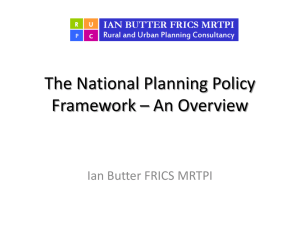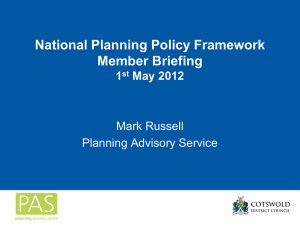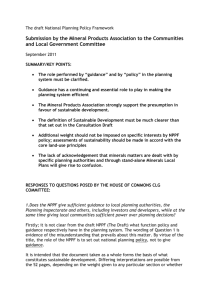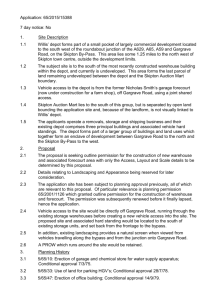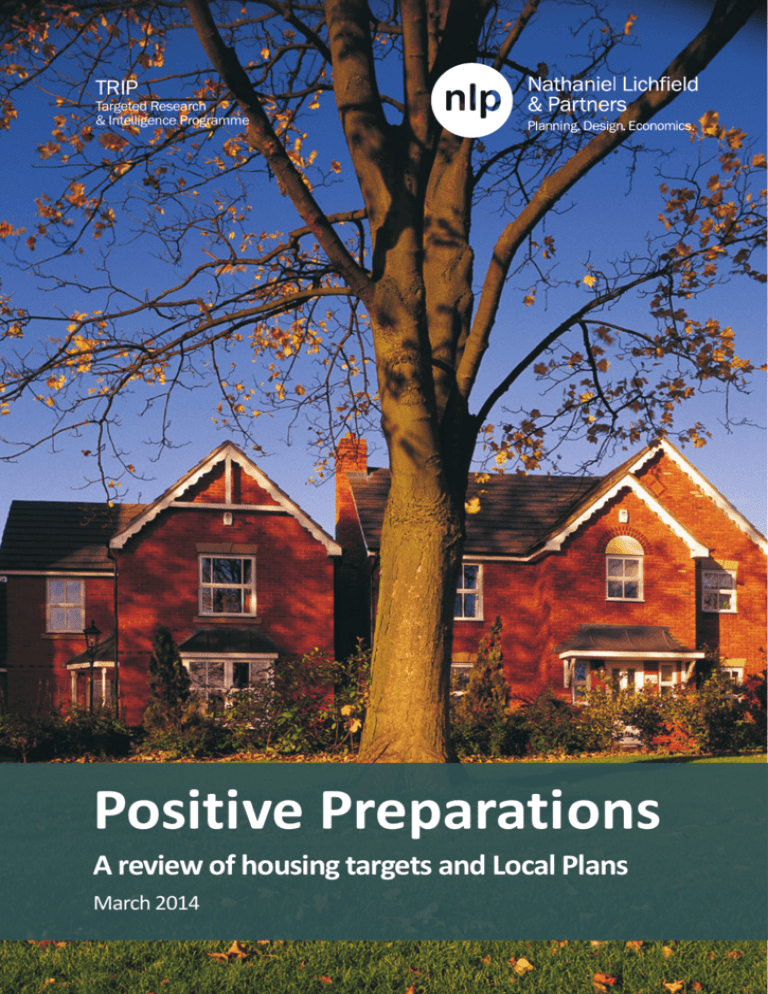
TRIP
Targeted Research
& Intelligence Programme
Positive Preparations
A review of housing targets and Local Plans
March 2014
Executive Summary
The NPPF was introduced two years ago as part of the Government’s attempt to make the
planning system less complex and more accessible. While one of the key aims of introducing
the NPPF was to simplify and speed up the planning process, two years down the line progress
on getting submitted Plans found sound appears to have slowed.
A review of the 109 Local Plans that have been examined or submitted for examination
since the NPPF was introduced confirms that the key reason Plans have stalled is the policy
requirement to meet objectively assessed needs, with the housing target remaining the key
battleground at examinations. Just over half of Plans propose less housing than had been
proposed by former Regional Strategies, but a third of sound plans end up having to increase
their target to pass examination.
Half of the plans submitted for examination since the NPPF have experienced delays. Progress
of many plans has stalled as LPAs take stock of their evidence base before proceeding with the
rigorous examination process. The number of Plans being withdrawn has increased in 2013/14
compared to 2012/13.
The review suggests eight core typologies of local plan each with their own strategy risks
and requiring different approaches to evidence, preparation and examination from both local
authorities and those in the development sector:
Positive Preparations
Underbounded Growers
Evidenced full needs and seeking to
meet them head on.
Unmet needs, but already built up to
the boundary or constraints.
Squeezed Inbetweeners
Unbalanced Strategies
Unconstrained locations, near
constrained growth areas, which have
to respond to pressures.
Economically ambitious but without
the housing to support it.
Lacking Evidence
Defer the Pain
Out-of-date, insubstantial or no
evidence on objectively assessed
housing needs.
Chasing an ‘early review’ as a solution
to unmet needs, with the hope of
future change in evidence/politics.
Pleading Constraints
Zombie Plans
Accepting needs but praying in aid of
constraints (e.g. Green Belt, SPA, AONB,
Infrastructure, Countryside).
High housing needs, but no new Local
Plan on the horizon and reliance on a
pre-NPPF Core Strategy.
The Review in Figures
109
40
15
48%
4
1/3
16
Local Plans examined or submitted for examination
Local Plans found sound
Local Plans withdrawn on the basis of soundness concerns
of the 54 ongoing Local Plans have experienced delays and
require modifications
Additional number of months that it takes on average
for Local Plans to be Found Sound Post-NPPF
of LPAs had to increase their submitted housing target in order
to be found sound
Local Plans submitted for examination post-NPPF and have been
ongoing for a year or more
Positive
Preparations
iii
Introduction
It is now two years since the NPPF was published,
yet data from the Planning Inspectorate on the
progress of Local Plans indicates that over half of
Local Authorities still have yet to formally publish
new Local Plans since the changes to the planning
system were made (illustrated by the red shaded
areas in Figure 1). Just 13% of local authorities
have an NPPF-compliant up-to-date adopted
Plan. Around a quarter have a plan submitted
and an examination underway or forthcoming.
The remainder, by definition, have no up-to-date
plan and applications for planning permission for
housing will be subject to the NPPF.
A revitalised economy is reinforcing the
development industry’s appetite to build, and given
the extent of England’s housing crisis and the policy
stipulations of the NPPF that Local Plans must
positively seek opportunities to meet the objectively
assessed need for new homes, housing figures are
under deep scrutiny in public examinations.
This will mean that the issue of local housing will
continue to be a common feature of the planning
debate for years to come and as LPAs continue to
update their Local Plans to comply with the new
system, all parties will continue to require evidence
to back up their position at examinations and
beforehand. The new National Planning Practice
Guidance provides welcome assistance in this
regard.
This report, which updates a similar NLP study
from last year , reviews progress on Local Plan
preparation, assesses what has happened
to housing targets during the process of plan
preparation, and identifies some common themes
in the form of eight typologies of local plan area,
based on experience to date.
Figure 1: Local Plan Progress, as at March 2014
24.7
55.1
7.1
13.1
Pre-NPPF Local Plan or
No Local Plan
Local Plan Published/
Submitted for Examination
Local Plan Found Sound
/ Adopted Post-Final NPPF
Local Plan Found Sound
/ Adopted Post-Draft NPPF
Positive
Preparations
1
1
Objectively Speaking: A review of Local Plan examinations, April 2013
Local Plans
Two years under the NPPF
40
109
Plans submitted
/examined
Post-NPPF
to immediate
25% Subject
/ early review
Found Sound
48% Require
Modifications
54
Ongoing
more evidence
69% Require
of objectively assessed
housing need
15
reason withdrawn
27% Main
due to failure to meet
duty to cooperate
Withdrawn
reason withdrawn
73% Main
due to housing numbers
Figure 2: Tracking Local Plan Progress Post-NPPF
Summary of Local Plan Progress
since the NPPF came into play
Since the National Planning Policy Framework
(NPPF) was introduced on 27 March 2012 109
plans have been examined or submitted for
examination outside London (Figure 2). Of these,
just 40 (37%) have been found sound and a
quarter of these are subject to immediate or
early review. In most cases the focus of the early
review for these plans is to check that they meet
objectively assessed needs for housing.
In the two years since the NPPF fifteen councils
have withdrawn their Plans with the main reason
for almost three quarters (73%) of these being in
relation to the provision of housing.
The remaining 54 Plans are ongoing. However,
almost half of these (48%) have experienced delays
and require further modifications to their original
submitted plans. Of the 26 Plans that require
modifications, 18 (69%) of these specifically
require more evidence of objectively assessed
housing need.
The slow progress for half of the submitted Plans
since the NPPF is partly because Local Plan making
is in the midst of an ‘evidence arms race’ as all
parties involved seek to present the strongest
evidence on housing need – drawing on the latest
data and increasingly refined assumptions on the
smallest detail - as ammunition for the examination
process.
Positive
Preparations
2
2
Generally, for plans that were found sound during the period when the NPPF coexisted with Regional Strategies.
Time it takes for plans to get
through is increasing
On average it now takes four months longer for
Plans to be found sound after being submitted than
it did before the NPPF was introduced (Figure 3).
Plans that were submitted and examined prior
to the NPPF took on average 10 months from
submission to being found sound.
A review of the 40 plans (outside London) that
have been found sound post-NPPF reveal that the
process has taken on average nearly 14 months
from submission to being found sound. During this
time a third of Plans required modifications to their
original submission.
Further work and amendments, subsequent
consultation and examinations prolonged the
process for these plans to be found sound and
ultimately adopted.
Submission
Pre-NPPF
Post-NPPF
Found Sound
9.7 months
13.7 months
Figure 3: Average time from Local Plan Submission to being Found Sound
Positive
Preparations
3
Almost half of ongoing plans require
further work
Figure 4 highlights the areas of the country where
councils have experienced delays of a year or more
in the process of Local Plan examination.
Almost half of the Plans ‘in the system’ require
further modifications. Progress has stalled in the
majority of these cases (69%) due to Inspectors
requiring more evidence of objectively assessed
housing need.
While the reasons for suspending the examination
process vary on a case-by-case basis, the majority
of councils have been required to reassess their
housing numbers. The need for further modifications has drawn out
the examination process for 16 (30%) of the 54
ongoing plans for over a year.
Over half of these councils’ have had their
examination process suspended for 6-12 months
while further work was undertaken to deal with
the issues raised by the Inspector concerning the
soundness of plans, particularly relating to housing
requirements.
The greater length of time to get plans through the
system is down to LPAs recognising the need to
build up the evidence base, and where necessary
revise their local policy, as required to support their
housing target submissions under the new planning
policy.
Figure 4: Plans in Waiting
2 years 11 months
1 year 10 months
1 year 8 months
1 year 8 months
1 year 6 months
13
1 year 6 months
1 year 5 months
6
1 year 3 months
5
1 year 3 months
7
16
12
10
8
1 year 3 months
11
3
1 year 2 months
1 year 2 months
14 2
15
Bath & North East Somerset
2
East Hampshire
3
Wiltshire
4
Rother
5
Warrington
6
Ribble Valley
7
Rushcliffe
8
South Northamptonshire
(South Northants JCS)
9
Northampton
(South Northants JCS)
10
Daventry
(South Northants JCS)
9
1 year 2 months
1
1
1 year
4
1 year
1 year
11
South Summerset
12
North Warwickshire
13
Richmondshire
14
East Dorset
15
Christchurch
16
Lichfield
Map to the left and chart above highlight Councils
whose plans have been submitted for examination and
have been ongoing for a year or more post-NPPF
Positive
Preparations
4
Positive
Preparations
5
Upward pressure on housing targets
In the first year of the NPPF, ten (53%) of the 19
Plans found sound proposed a reduction against the
RS target at submission stage, with the remainder
being in line with the RS (Figure 5). During the
examination process eight required an increase to
housing targets after submission.
By comparison in the second year of the NPPF,
eight (38%) of the 21 Plans found sound proposed
a reduction against the RS target at submission
stage, indicating a greater proportion of LPAs
submitting figures in line or above the RS. During
the examination process five required an increase
to housing targets after submission.
The outcome among the 40 Plans found sound
since NPPF has been that only nine (23%) were
found sound with a reduced target against their
RS target, with three of these (Milton Keynes,
Bournemouth, Taunton Deane) justified by the
virtue of being above CLG household projections
and therefore meeting an objective assessment of
housing need.
Only six (15%) of the 40 Plans found sound since
the NPPF was introduced have had an outcome of a
reduction against the RS target and a target below
the CLG household projections. Of these, over half
are subject to the requirement for early review with
a focus on the housing target.
Analysis of the Plans found sound within the two
years of the NPPF indicate that initially many
local authorities aspired to reduce their housing
requirement, with over half of Local Plans submitted
in the first year of the NPPF having housing targets
below the RS. However given the intense debate
over housing at examinations and the fact that
housing numbers are often the most stringently
assessed and contested parts of the Local Plan,
this has led to further revisions and modifications
and ultimately the majority of Plans at least
meeting their RS target.
In the second year of the NPPF 13 Plans,
representing 62% of the Plans found sound in
that year, proposed housing targets above or in
line with the RS. The outcome for year two of the
NPPF resulted in over three quarters of Plans (16)
adopting targets that met or exceeded the RS. Over
half of these (9) were found sound with a housing
target that meets or exceeds both the RS and CLG
household projections target.
In the second year of the NPPF fewer plans have
required an increase to housing targets after
submission. While 42% of the 19 plans found
sound in the first year required an increase, only
29% of the 21 in the second year had to raise
housing numbers after submission (see Figure 7).
RS Targets
NPPF Year 1
April 2012 - March 2013
NPPF Year 2
April 2013 - March 2014
CLG HH projections*
47%
53%
Proposed RS
figure
43%
Proposed RS
figure
Proposed a
reduction on RS
19%
38%
Proposed
RS figure
Proposed a
reduction on RS
47%
Proposed RS
figure
57%
Proposed RS
figure
53%
Proposed a
reduction on RS
5% 53%
Proposed
Proposed a
the same reduction on RS
Figure 5: Proposed housing targets compared to RS and Household Projections
Positive
Preparations
6
* Figures against relevant HH projections for review period. Plans submitted for examination in NPPF Year 1 were reviewed
against 2008 HH projections. Plans submitted for examination in NPPF Year 2 were reviewed against 2011 HH projections.
Meets / exceeds
Regional Strategy target
Meets / exceeds
household projections
Percentage of
sound Local Plans
NPPF Year 1
(April 2012 0 March
2013)
NPPF Year 2
(April 2013 - March
2014
42%
43%
11%
5%
37%
33%
11%
19%
Figure 6: Housing Targets in Sounds Plans in Years 1 & 2 post-NPPF
NPPF Year 1
April 2012 - March 2013
19
58%
No change to housing
Targets after submission
42%
Required increase to housing
targets after submission
71%
No change to housing
Targets after submission
29%
Required increase to housing
targets after submission
(11)
Plans found sound
(8)
NPPF Year 2
April 2013 - March 2014
21
Plans found sound
(15)
(6)
Figure 7: Submitted housing targets vs adopted housing targets for Local Plans found sound post-NPPF
Positive
Preparations
7
More plans are failing the
Duty to Cooperate
There are also signs of increasing pressure on
localities to make the duty to cooperate process
work more effectively. As the remnants of the RS
fade away, clear evidence of cooperation with
surrounding Authorities is becoming an integral
concern for many Inspectors’ reviews of Plans.
In the second year of the NPPF three plans were
withdrawn over their failure to meet the duty to
cooperate with neighbouring councils.
By comparison none of the plans withdrawn in the
first year were primarily due to failure to meet duty
to cooperate. A further four plans that have been
submitted for examination in the second year of
the NPPF have become unstuck due to duty to
cooperate.
Positive
Preparations
8
LPAs must effectively account for cross-boundary
issues in their Plans; and even if authorities better
get to grips with the statutory process of the legal
duty, the underlying soundness of meeting needs
across a housing market area remains a concern in
situations where constraints on delivery in one area
impose unmet requirements on another.
The ‘London dimension’ (arising from the current
draft Further Alterations to the London Plan, with a
housing target set well below levels of need) poses
perhaps the greatest challenge in this regard.
Positive
Preparations
9
Positive Preparations
Typologies of Local Plan
What issues are likely to emerge in the future for
housing targets in Plans? Reviewing the issues
frequently debated at examinations, some common
themes emerge which suggest a range of Local
Plan typologies, each characterised by the risks to
the soundness of the strategy put forward.
Figure 8 (opposite) outlines these typologies,
from the ‘underbounded growers’ who haven’t got
the space to deliver the housing they need, to
the ‘lacking evidence’ who don’t know what their
need is (or deny that it exists) and the ‘pleading
constraints’ who may acknowledge their need
but assert that they can’t deliver due to their
insurmountable constraints.
In reality, there are many Local Plans which are
straddling numerous typologies, either through
coincidence or by design. Each typology brings with
it risks to the overall strategy for meeting housing
needs which may be explored through examination,
where the evidence is put to the Inspector.
Positive
Preparations
10
There are also areas with pre-NPPF adopted Core
Strategies continuing to rely on Regional Strategy
based housing targets, and therefore 5 year land
supply positions, in the face of higher needs; the
so-called ‘Zombie Plans’ as they live on despite
potentially being out-of-date and effectively dead.
Sevenoaks is the most obvious example, losing
a spate of housing appeals in early 2014 as the
housing policies, including the requirement, in the
plan were “not up-to-date with the approach now
put forward in the NPPF.”
Using the typologies as a basis for reviewing any
Plan’s effectiveness, the focus should be on the
requirement for robust, adequate, up-to-date and
relevant evidence on housing needs and constraints
to delivery. These are an integral part of the Plan
making process so participants can actively engage
in its examination to achieve positive outcomes.
‘Positive Preparations’
‘Underbounded Growers’
Evidenced full needs and seeking to meet them
head on.
Unmet needs, but already built up to the boundary
or constraints.
Strategy Risks: Demonstrating deliverability and
right spatial strategy.
Strategy Risks: Leave no stone unturned in finding
opportunities to meet needs.
Example: Chesterfield
Example: Brighton
‘Squeezed Inbetweeners’
‘Unbalanced Strategies’
Unconstrained locations, near constrained growth
areas, which have to respond to pressures.
Economically ambitious but without the housing to
support it.
Strategy Risks: Demonstrating the Duty to
Cooperate with neighbouring authorities
Strategy Risks: Misalignment between jobs and
homes.
Example: Aylesbury Vale
Example: South Worcestershire
‘Lacking Evidence’
Out-of-date, insubstantial or no evidence on
objectively assessed housing needs.
Strategy Risks: Not justfied by the evidence.
Example: West Northamptonshire
‘Defer the Pain’
Chasing an ‘early review’ as a solution to unmet
needs, with the hope of future change in evidence/
politics.
Strategy Risks: Early review as a panacea for an
unsound plan.
Example: Dacorum
‘Pleading Constraints’
Accepting needs but praying in aid of constraints
(e.g. Green Belt, SPA, AONB, Infrastructure,
Countryside).
Strategy Risks: Constraint led approach leading
to unmet needs in the market area. Duty to
Cooperate.
‘Zombie Plans’
High housing needs, but no new Local Plan on the
horizon and reliance on a pre-NPPF Core Strategy.
Strategy Risks: Weakened defence on appeals
Example: Sevenoaks
Example: Reigate and Banstead
Figure 8: Local Plan Typologies
Positive
Preparations
11
Date
Submitted
Jan-14
Jan-14
Dec-13
Dec-13
Dec-13
Dec-13
Dec-13
Dec-13
Dec-13
Dec-13
Dec-13
Nov-13
Oct-13
Oct-13
Oct-13
Oct-13
Oct-13
Sep-13
Aug-13
Aug-13
Aug-13
Aug-13
Jul-13
Jul-13
Jul-13
Jun-13
Jun-13
Jun-13
Jun-13
Cherwell
Runnymede
Amber Valley
Cheshire West and Chester
Charnwood
Southampton
Stroud
Ashfield
Bolsover
Mendip
Bury
Leicester
Colchester
Allerdale
Lincoln
North Kesteven
West Lindsey
Fenland
East Cambridgeshire
Stafford
Aylesbury Vale
East Devon
Thurrock
Mid Sussex
Knowsley Metropolitan
Swindon
Brighton & Hove
North West Leicestershire
West Dorset (Joint West Dorset,
Weymouth & Portland)
12
LPA
Ongoing
Withdrawn
Ongoing
Ongoing
Ongoing
Ongoing
Ongoing
Ongoing
Withdrawn
Ongoing
Ongoing
Ongoing
Withdrawn
Withdrawn
Withdrawn
Ongoing
Ongoing
Ongoing
Ongoing
Ongoing
Ongoing
Ongoing
Ongoing
Ongoing
Ongoing
Ongoing
Ongoing
Ongoing
Ongoing
Outcome
~
~
~
~
~
~
~
~
~
~
~
~
~
~
~
~
~
~
~
~
~
~
~
~
~
~
~
~
~
~
~
~
~
~
~
~
~
~
~
~
~
~
~
~
~
~
~
~
~
~
~
~
~
~
~
~
~
~
Date Time from
Found Submission to
Sound Found Sound
(months)
South West
East Midlands
South East
South West
North West
South East
East of England
South West
South East
West Midlands
East of England
East of England
East Midlands
East Midlands
East Midlands
North West
East of England
East Midlands
North West
South West
East Midlands
East Midlands
South West
South East
East Midlands
North West
East Midlands
South East
South East
Region
625
510
570
1800
450
855
950
855
1345
550
430
510
480
560
990
267
830
1280
500
415
400
560
455
815
790
1317
510
286
670
RS Target
(p.a.)
Benchmark
Appendix 1 - Table of Local Plans Submitted for Examination Against NPPF
Year 2 of NPPF
Positive
Preparations
Planned Provision
419
310
798
1354
241
543
909
555
988
417
796
693
524
581
119
130
1220
701
626
421
222
394
406
779
880
496
460
568
688
482
510
565
1250
450
411
950
749
675
500
495
550
2253
304
830
1280
400
415
300
482
380
795
790
1100
470
220
670
~
~
~
~
~
~
~
~
~
~
~
~
~
~
~
~
~
~
~
~
~
~
~
~
~
~
~
~
~
CLG HH
Submission Sound/
Proj (p.a.)* Target
Adopted
Target
-143
0
-5
-550
0
-444
0
-106
-670
-50
65
40
-480
-560
1263
37
0
0
-100
0
-100
-78
-75
-20
0
-217
-40
-66
0
Proposed
Reduction on RS
Increase/Decrease
63
200
-233
-104
209
-132
41
194
-313
83
-301
-143
-524
-581
2134
174
-390
579
-226
-6
78
88
-26
16
-90
604
10
-348
-18
~
~
~
~
~
~
~
~
~
~
~
~
~
~
~
~
~
~
~
~
~
~
~
~
~
~
~
~
~
~
~
~
~
~
~
~
~
~
~
~
~
~
~
~
~
~
~
~
~
~
~
~
~
~
~
~
~
~
Outcome Outcome
Against Against
Proposed
RS
HH
Reduction
Against HH
~
~
~
~
~
~
~
~
~
~
~
~
~
~
~
~
~
~
~
~
~
~
~
~
~
~
~
~
~
Change
After
Submission
Ongoing
Ongoing
Ongoing
Ongoing
Ongoing
Ongoing
Ongoing
Ongoing
Ongoing
Sound
Withdrawn
Jun-13
Jun-13
Jun-13
Jun-13
May-13
May-13
May-13
May-13
May-13
May-13
Apr-13
Apr-13
Apr-13
Broxtowe (Aligned Core Strategy)
Gedling (Aligned Core Strategy)
Nottingham(Aligned Core Strategy)
Rochdale
Malvern Hills (South Worcestershire
Development Plan)
Worcester (South Worcestershire
Development Plan)
Wychavon (South Worcestershire
Development Plan)
Gravesham
Ongoing
~
~
~
~
~
~
~
~
~
~
~
~
~
~
~
~
Oct-13 6.5
~
~
~
~
~
~
~
~
~
~
~
~
~
~
Yorkshire & Humber
East of England
Yorkshire & Humber
South East
West Midlands
West Midlands
West Midlands
North West
West Midlands
Yorkshire & Humber
East Midlands
East Midlands
East Midlands
South West
South West
South West
1700
700
4300
465
475
175
250
400
290
1160
1000
400
340
1338
795
280
1101
659
4082
481
384
202
240
322
232
544
1143
357
414
1449.7
511
153
1545
800
4375
271
370
229
204
400
241
850
1009
426
362
700
620
179
~
800
~
~
~
~
~
~
~
~
~
~
~
~
~
~
-155
100
75
-194
-105
54
-46
0
-49
-310
9
26
22
-638
-175
-101
** subject to immediate/early review of Local Plan, including housing target
*Benchmarked against relevant CLG HH projections base for examination period. Plans submitted for examination in Year 1 of the NPPF were benchmarked
against CLG 2008 HH Proj (08-33). Plans submitted for examination in Year 2 of the NPPF were benchmarked against CLG 2011 HH Proj (p.a. 11-21)
Kirklees
Chelmsford
Leeds
Cannock Chase
Rotherham
Ongoing
Jun-13
Ongoing
Ongoing
Jun-13
Ongoing
Jun-13
North Somerset
Weymouth and Portland (Joint West
Dorset, Weymouth & Portland)
Teignbridge
Positive
Preparations
13
444
141
293
-210
-14
27
-36
78
9
306
-134
69
-52
-750
109
26
~
100
~
~
~
~
~
~
~
~
~
~
~
~
~
~
~
141
~
~
~
~
~
~
~
~
~
~
~
~
~
~
~
+0
~
~
~
~
~
~
~
~
~
~
~
~
~
~
Mar-13
Mar-13
Feb-13
Feb-13
Feb-13
Feb-13
Feb-13
Jan-13
Jan-13
Dec-12
Dec-12
Dec-12
Nov-12
Nov-12
Mar-13
Nov-12
Oct-12
Oct-12
Oct-12
Oct-12
Oct-12
Sep-12
Sep-12
Sep-12
Sep-12
Sep-12
Sep-12
Jul-12
Jul-12
Jun-12
Jun-12
Christchurch
East Dorset
Richmondshire
North Warwickshire
Broadland (Joint Revision)
Norwich (Joint Revision)
South Norfolk (Joint Revision)
Waverley
South Somerset
Daventry (South Northants JCS)
Northampton (South Northants JCS)
South Northamptonshire (South
Northants JCS)
Erewash
Tamworth
Hart
Babergh
Copeland
Hastings
Rushcliffe
West Lancashire
Coventry
Chesterfield
Melton
Ribble Valley
Warrington
Solihull
Staffordshire Moorlands
Rother
Wiltshire
Hartlepool
Dacorum
Date
Submitted
Mar-13
14
Lichfield
LPA
Year 1 of NPPF
Positive
Preparations
Sound
Withdrawn
Ongoing
Ongoing
Sound
Sound
Ongoing
Ongoing
Withdrawn
Sound
Withdrawn
Sound
Ongoing
Sound
Sound
Sound
Withdrawn
Withdrawn
Sound
Ongoing
Ongoing
Ongoing
Ongoing
Withdrawn
Sound
Sound
Sound
Ongoing
Ongoing
Ongoing
Ongoing
Ongoing
Outcome
~
~
~
~
~
~
~
~
~
~
~
~
10.9
~
10.9
~
~
~
~
~
~
Jul-13 12.6
~
~
~
Jan-14 15.7
Nov-13 14.0
~
~
~
Jun-13 8.7
~
Sep13
~
Oct-13 11.7
Sep13
Jan-14 14.3
~
~
Jan-14 13.5
~
~
~
~
~
Nov-13 9.3
Nov-13 9.3
Nov-13 9.3
~
~
~
~
~
Date Time from
Found Submission to
Sound Found Sound
(months)
East of England
North East
South West
South East
West Midlands
West Midlands
North West
North West
East Midlands
East Midlands
West Midlands
North West
East Midlands
South East
North West
East of England
South East
West Midlands
East Midlands
East Midlands
East Midlands
East Midlands
South West
South East
East of England
East of England
East of England
West Midlands
Yorkshire & Humber
South West
South West
West Midlands
Region
600
395
1900
280
300
435
380
161
170
380
740
300
750
210
230
280
220
145
360
2485
985
250
560
705
610
150
200
320
173
450
RS Target
(p.a.)
Benchmark
520
280
2160
560
280
640
840
240
160
360
1200
240
520
360
240
400
400
200
360
520
1480
400
800
440
720
1000
680
250
200
320
200
440
430
320
1850
218
275
500
500
200
170
380
669
310
553
200
230
300
236
205
368
373
1527
353
830
230
862
477
706
164
180
294
225
435
430**
~
~
~
300
500
~
~
~
380
~
310
~
214
230
300
~
~
368
~
~
~
~
~
862
477
706
~
~
~
~
~
CLG HH
Submission Sound/
Proj (p.a.)* Target
Adopted
Target
Planned Provision
-170
-75
-50
-62
-25
65
120
39
0
0
-71
10
-197
-10
0
20
16
60
8
373
1527
-2132
-155
-20
302
-228
96
14
-20
-26
52
-15
Proposed
Reduction on RS
Increase/Decrease
-90
40
-310
-342
-5
-140
-340
-40
10
20
-531
70
33
-160
-10
-100
-164
5
8
-147
47
-47
30
-210
142
-523
26
-86
-20
-26
25
-5
Proposed
Reduction
Against HH
-170
~
~
~
0
65
~
~
~
0
~
10
~
4
0
20
~
~
8
~
~
~
~
~
302
-228
96
~
~
~
~
~
-90
~
~
~
20
-140
~
~
~
20
~
70
~
-146
-10
-100
~
~
8
~
~
~
~
~
142
-523
26
~
~
~
~
~
Outcome Outcome
Against Against
RS
HH
+0
~
~
~
+25
+0
~
~
~
+0
+0
~
+14
+0
+0
~
~
+0
~
~
~
~
~
+0
+0
+0
~
~
~
~
~
Change
After
Submission
Ongoing
Withdrawn
Sound
Sound
Sound
Sound
Sound
Sound
Withdrawn
Sound
Sound
Sound
Withdrawn
Sound
Sound
Sound
Sound
Sound
Sound
Sound
Sound
Sound
Sound
Sound
Sound
Sound
Sound
May-12
May-12
May-12
May-12
May-12
Mar-12
Feb-12
Feb-12
Feb-12
Jan-12
Jan-12
Jan-12
Jan-12
Dec-11
Nov-11
Nov-11
Sep-11
Sep-11
Sep-11
Aug-11
May-11
May-11
May-11
Mar-11
Mar-11
Mar-11
Mar-11
Mar-11
Mar-11
Apr-10
Suffolk Coastal
Mid Suffolk (Focussed Review)
Selby
Bath & North East Somerset
Chorley (Central Lancashire JCS)
Preston (Central Lancashire JCS)
South Ribble (Central Lancashire JCS)
15
Sound
Sound
~
~
6.2
9.8
~
~
26.9
Jul-12 26.8
May13
Nov-13 31.5
Oct-12 19.2
Jun-12 14.3
Jun-12 14.3
Jun-12 14.3
~
Jun-13 25.5
Oct-12 16.1
Oct-12 14.9
Aug-13 23.4
Oct-12 13.3
Oct-12 12.7
Jul-12 7.6
Aug-12 9.5
Jul-12 7.2
~
Oct-12 9.2
Jun-13 16.3
Nov-12 9.7
~
Dec12
Nov-12 8.7
Sep12
Jun-13 12.9
Aug-13 14.8
Jan-14 20.4
~
~
Feb-13 8.2
Feb-13 7.8
South East
South East
South West
South East
North West
North West
North West
South West
Yorkshire & Humber
North West
South East
North West
West Midlands
North West
South West
South West
South East
Yorkshire & Humber
South West
South East
South East
South East
East of England
East of England
East of England
East of England
Yorkshire & Humber
South East
North West
South East
East Midlands
South East
525
2068
1640
547
417
507
417
1065
440
570
550
978
175
500
1090
805
292
1150
258
290
240
815
250
260
415
510
200
500
1600
535
380
612
889
1560
1600
440
400
400
360
800
520
360
680
880
200
280
520
440
400
1560
160
560
680
880
480
400
640
1000
240
840
1080
400
360
520
525
1750
1610
547
334
406
334
575
440
570
410
1000
175
500
850
730
292
1088
120
350
240
815
237
260
415
446
200
460
1300
442
365
550
525**
1750**
1692**
547
417
507
417
~
450
570
450**
1000
175
552
850
730**
292
~
120**
400
240
~
260**
260
415
465**
200**
460
~
~
380
625
0
-318
-30
0
-83
-101
-83
-490
0
0
-140
22
0
0
-240
-75
0
-62
-138
60
0
0
-13
0
0
-64
0
-40
-300
-93
-15
-62
** subject to immediate/early review of Local Plan, including housing target
*Benchmarked against relevant CLG HH projections base for examination period. Plans submitted for examination in Year 1 of the NPPF were benchmarked
against CLG 2008 HH Proj (08-33). Plans submitted for examination in Year 2 of the NPPF were benchmarked against CLG 2011 HH Proj (p.a. 11-21)
West Berkshire
Milton Keynes
South Gloucestershire
South Oxfordshire
St Helens Metropolitan
Wealden District
Wigan Metropolitan
South Staffordshire
Halton Borough
Taunton Deane
Bournemouth
Woking
Kingston upon Hull
Purbeck
Shepway
Eastbourne
Medway
Hertsmere
Watford
Ryedale
Reigate & Banstead
Salford
East Hampshire
Ongoing
Sound
Jun-12
Blaby
Sound
Jun-12
Winchester
Positive
Preparations
-364
190
10
107
-66
6
-26
-225
-80
210
-270
120
-25
220
330
290
-108
-472
-40
-210
-440
-65
-243
-140
-225
-554
-40
-380
220
42
5
30
0
-318
52
0
0
0
0
~
10
0
-100
22
0
52
-240
-75
0
~
-138
110
0
~
10
0
0
-45
0
-40
~
~
0
13
-364
190
92
107
17
107
57
~
-70
210
-230
120
-25
272
330
290
-108
~
-40
-160
-440
~
-220
-140
-225
-535
-40
-380
~
~
20
105
+0
+0
+82
+0
+83
+101
+83
~
+10
+0
+40
+0
+0
+52
+0
+0
+0
~
+0
+50
+0
~
+23
+0
+0
+19
+0
+0
~
~
+15
+75
Positive
Preparations
16
About NLP
Nathaniel Lichfield & Partners (NLP) is an
independent planning, economics and urban design
consultancy, with offices in Cardiff, Leeds, London,
Manchester and Newcastle.
We prepare accessible and clear reports,
underpinned by robust analysis and stakeholder
engagement, and provide expert witness evidence
to public inquiries and examinations.
NLP is currently RTPI Planning Consultancy of
the Year and Just Giving Company of the Year.
We are one of the largest independent planning
consultancies in the UK and we offer the broadest
range of skills of any specialist planning firm. This
includes services in demographics, economics,
heritage, sustainability, urban design and sunlight
and daylight, as well as a full range of planning
skills.
Our targeted research reports explore current
planning / economic issues and seek to offer
practical ways forward.
Read More
You can find out more information on NLP and
download copies of this report at:
www.nlpplanning.com/nlp-insight
Our clients include local authorities and government
bodies, as well as developers, landowners
and operators in the housing, retail, leisure,
commercial, and infrastructure sectors.
How NLP can help
UNLOCK
Strategic & ResidenƟal
Land PromoƟon
Promoting
Strategic Land
Assessing
Housing Needs
Evidencing
Economic Benefits
Assessing
Economic Needs
Contacts
For more information, please contact us:
Cardiff
Gareth Williams
029 2043 5880
gwilliams@nlpplanning.com
Leeds
Justin Gartland
0113 397 1397
jgartland@nlpplanning.com
London
Matthew Spry
0207 837 4477
mspry@nlpplanning.com
Manchester
Michael Watts
0161 837 6130
mwatts@nlpplanning.com
Newcastle
Michael Hepburn
0191 261 5685
mhepburn@nlpplanning.com
This publication has been written in general terms and cannot be relied on to cover specific situations. We recommend
that you obtain professional advice before acting or refraining from acting on any of the contents of this publication. NLP
accepts no duty of care or liability for any loss occasioned to any person acting or refraining from acting as a result of any
material in this publication.
Nathaniel Lichfield & Partners is the trading name of Nathaniel Lichfield & Partners Limited. Registered in England,
no.2778116.
Registered office: 14 Regent’s Wharf, All Saints Street, London N1 9RL
© Nathaniel Lichfield & Partners Ltd 2014. All rights reserved.
Planning
Consultancy
2011-2012
Applications & Appeals
2012-2013
Climate Change &
Sustainability
Community Engagement
of the Year
Daylight & Sunlight
TRIP
Targeted Research
& Intelligence Programme
nlpplanning.com
Economics & Regeneration
Environmental Assessment
Expert Evidence
GIS & Graphics
Heritage
Property Economics
Site Finding & Land Assembly
Strategy & Appraisal
Urban Design


